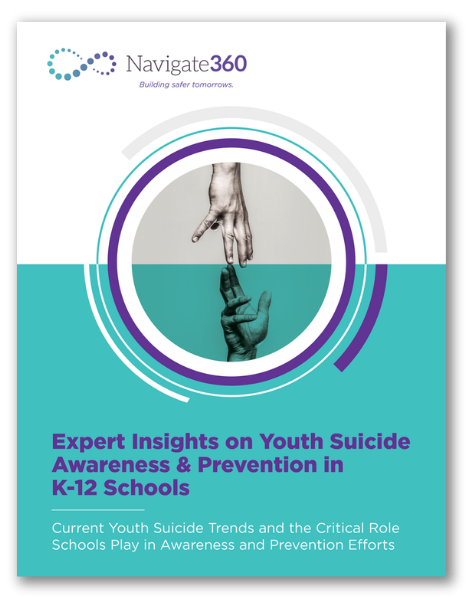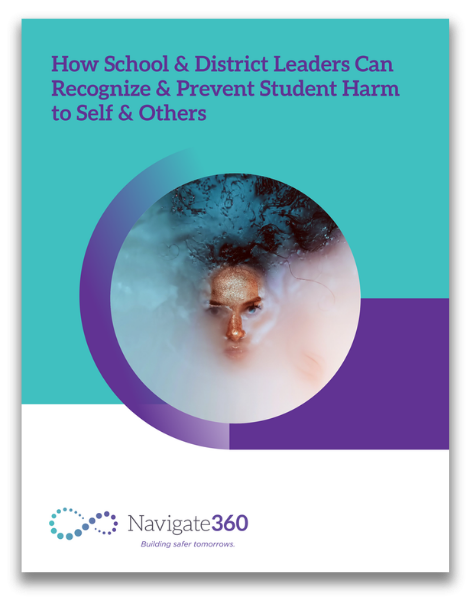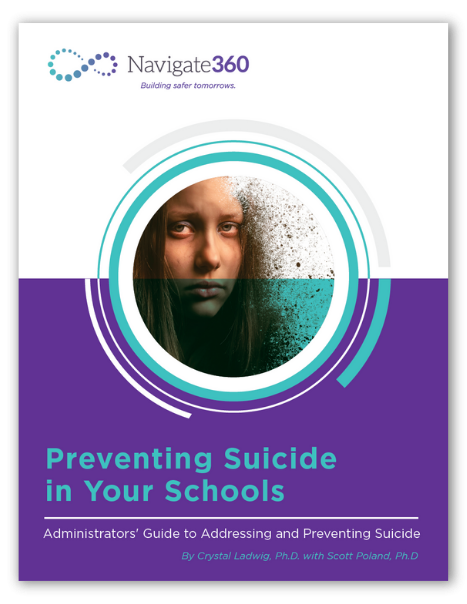Current Youth Suicide Trends and the Critical Role Schools Play in Awareness and Prevention Efforts
For decades, mental health experts have been sounding the alarm about the rising number of young people taking their own lives, yet the grim statistics continue to climb. The suicide rate for Americans ages 10 to 24 has gone up a staggering 60% since 2007, according to the Centers for Disease Control and Prevention (CDC), and, as astounding as it may seem, suicide remains the second leading cause of death for children ages 10 and up, according to the National Institute of Mental Health.
Furthermore, a poll was conducted in April 2021 by Navigate360 and John Zogby Strategies to identify the level of risk students are facing. Nearly 60% of teens surveyed in the April 2021 poll — or about three in every five teenagers — said they know someone who has considered committing self-harm or suicide. That’s a three-point increase from the results of a similar poll conducted four months earlier. These findings echo the broad understanding that youth suicide is on the rise, and it will take an all-hands-on-deck approach to educate and support students if we want to see real, institutionalized change.
In a single year, children will spend half their time at school. With educators, counselors, administrators and other school staff often interacting with students just as much as their family members, friends and community leaders, schools play a critical role in developing awareness and prevention programs.
The reasons for the trend are complex, but it’s clear that suicide prevention solutions are needed now more than ever. With students going back to school after a global pandemic and constantly evolving triggers and outside influences growing, schools must be proactive when it comes to developing effective suicide awareness programs and prevention techniques.
The issue of youth suicide is not only crucial, but dire. And unfortunately, time is of the essence, because children’s lives literally depend upon it.
What you know can save a life.
Use these links to quickly jump to a specific section within this resource:

Download your free copy of Expert Insights on Youth Suicide Prevention for K-12 Schools.
The Importance of Effective Youth Suicide Awareness & Prevention Programs in Schools Today
According to results of the CDC’s most recent Youth Risk Behavior Survey conducted in 2019, about 19% of high school students said they had seriously considered attempting suicide. That’s up from less than 14% in 2009, the earliest year for which data was listed in the CDC survey. Results from 2019 also indicated that almost 17% of students had made a suicide plan and nearly 9% had attempted suicide, up from 11% and 6%, respectively, in 2009. Furthermore, nearly 37% of students — more than a third — reported experiencing persistent feelings of sadness or hopelessness during 2019.
Additional research, including a 2019 study published in the journal Pediatrics, concludes that adults are frequently in the dark about the suicidal thoughts of the teens closest to them.
These troubling findings highlight the need for an increased focus on suicide awareness and prevention in schools, communities and families to combat the upward trends.
Meet the Expert: Scott Poland, Ed.D.
What’s Fueling the Youth Suicide Trend?
Every young person who contemplates, attempts or commits suicide is unique. However, researchers have identified a leading cause of youth suicide: untreated or undertreated mental illness, often combined with one or more adverse childhood experiences (ACEs).
Dr. Scott Poland identifies the most common adverse childhood events as:
- Rejection from a natural parent
- Physical, emotional or sexual abuse
- Living in poverty
- Living with a mentally ill parent
- Being the victim of a bully
No child’s experience is exactly the same, so it’s important to understand the deeper relationship between some of the most common triggers.
The Relationship Between the COVID-19 Pandemic and Suicide
Surveyors from the April 2021 Navigate360 & Zogby poll asked parents about the effects of the COVID-19 pandemic on their children younger than 17. Seventy-eight percent said they worried about how coronavirus-related feelings of isolation and stress about family health and income were affecting the mental health of their children. However, only 62% reported that they had talked to their children about mental health issues. Moreover, although 62% of parents said schools have sufficient resources to deal with mental health concerns, less than half of young adults agreed.
The Relationship Between Bullying & Suicide
Few school administrators would dispute that bullying is an ongoing problem on campuses across the nation, and the results of the April 2021 Navigate360/Zogby Strategies poll illuminate the extent of the issue. Half of the teens (49%) and parents (51%) surveyed said they were aware of a student who was bullied because of race, sexual orientation or income level. Students are also at a loss as to what to do when they or someone they know is threatened — only 42% of teens surveyed said they knew where and how to report a threat or risk.
The Navigate360/Zogby survey results are especially poignant because researchers have identified an unmistakable association between bullying and suicide. What the research has shown is that bullying can lead to thoughts of suicide for both the perpetrator and the victim, not just one or the other. Dr. Poland recommends that when students are involved in bullying, educators and counselors should ask both the initiator and the recipient whether they’re experiencing feelings of hopelessness and/or thoughts of suicide.
The Relationship Between Self-Injury as a Coping Mechanism & Suicide
Adolescents sometimes resort to intentional self-injury, especially cutting themselves, as a way to relieve anxiety and feelings of despair. The injury triggers the brain to release endorphins that help regulate emotions, Dr. Poland explains. However, as time goes on, the behavior loses its potency. Meanwhile, teens who indulge in cutting are becoming increasingly comfortable with harming their bodies, which moves them closer to the possibility of committing suicide.
“So, whenever we know a kid’s engaging in self-injury,” Dr. Poland says, “we should ask them, ‘Have you ever thought about suicide?’”

Discover What You Can do to Prevent Harm in Your Schools
Download your free copy of How School & District Leaders Can Recognize & Prevent Student Harm to Self & Others today.
Youth Suicide Prevention Techniques
The prevention of adolescent suicide isn’t solely up to schools, which are only one prong in a comprehensive approach that must include parents and the community. However, as the place where most children spend at least half of their days every year, schools play a critical role in preventing youth suicide. Students who are thinking about suicide often display warning signs that may be observed in the classroom, hallways and lunchroom, or even during school-sponsored extracurricular events on and off campus.
The most powerful technique for preventing youth suicide is creating a safe space for educators to talk to their students about it. That’s why it’s absolutely essential that educators are trained and able to be a part of the dialogue, so students know that they can go to them for help if they or their friends are having thoughts of suicide.
“It’s important that all school personnel know what to look for, what to do, and work as a team to prevent a student suicide,” Dr. Poland says.
School administrators who enact proven strategies to prevent youth suicide, as well as help surviving students cope in the aftermath of a classmate’s suicide, will take a vital step toward making students feel safe on campus. The need for improvements in this area is highlighted in the results of the April 2021 Navigate360/Zogby Strategies survey. Only 38% of teen respondents said they were confident that school officials can create an atmosphere of physical and social-emotional safety in the classroom.
Recognizing Warning Signs of Youth Suicide
We all know that every student and child is different, so the warning signs of youth suicide will vary depending on each individual’s situation, personality and environment. It’s impossible to see everything or be everywhere at once, but recognizing and being aware of common triggers, warning signs and behaviors can help educators recognize potentially dangerous situations.
Here are some of the common signs that a child could be at risk:
Students withdrawing from family and friends
Parents always feel like they know their children best, but students spend the majority of their lives in school. As a result, it stands to reason that teachers and educators will observe changes in a child’s behavior, like who they sit with at lunch or who they used to be friends with, before a parent is aware. Students who were previously close with their parents or siblings who have become detached are often battling something internally, and this could be an early sign of depression or suicidal thoughts.
Students spending more time alone or only interacting with others online
Due to COVID-19, students had no choice but to spend less time in person with friends, extended family and teachers. However, retreating into social isolation is a common warning sign of suicidal behavior. As kids begin to re-enter a post-pandemic world, it’s important to take note of how they adjust to their new normal.
Students imitating suicidal behavior
Unfortunately, students do sometimes imitate suicidal behavior. The students who do so typically are not the friends of a student who committed suicide. More commonly, the students at highest risk are those who are struggling and thinking about suicide. When they learn of a suicide at their school, they may identify with the suicidal student’s problems and start planning to take action.
“Suddenly, following through on a suicide attempt seems more viable because [a suicide] actually happened,” Poland explains.
Students frequently talking about suicide
Every single time a student makes a suicidal statement, there are steps that must be taken to make an assessment and notify the parents. Even when kids are joking, the statement must be evaluated, if for no other reason than to avoid harmful statements in the future.
What Should Schools Do if a Student Is Suspected of Being Suicidal?
The primary role of schools in suicide prevention is to make an initial assessment of whether the student who is thought to be suicidal is at immediate risk and then take appropriate action to keep the student safe. According to Dr. Poland, every school should have key staff members, such as social workers, counselors or school psychologists, who have been trained to ask the student certain direct questions. The questions are listed in the Columbia Suicide Severity Rating Scale that’s referenced in the Navigate360 Suicide Awareness and Prevention course.
Once initial assessment and suicide prevention measures are taken, school staff should use the information to refer the student to more comprehensive community-based counseling and treatment while continuing to monitor the student’s progress.
It is also essential that parents be notified of their child’s suicidal behavior, unless there are suspicions that the student is a victim of child abuse. If abuse is suspected, then the school should call protective services.
Dr. Poland’s guidance? “The best scenario is the suicidal student is handed off to a parent, law enforcement or a mobile crisis team.”
Prevention Steps for Educators with Students Exhibiting Suicidal Behavior
School Counselors
In a society and profession where privacy concerns are front and center, many school counselors may wonder with whom they can share their knowledge that a student is suicidal. Dr. Poland says the principal and teachers should definitely be informed so that they can be on the alert for signs that the student is in distress.
Once they’ve either been notified of a potentially suicidal student or have observed a dangerous situation, counselors do not need to wait for confirmation from the student to take action. While their role does require caution and careful consideration, they cannot wait until they’re 100% certain of an issue because by that point, it may be too late. It’s the counselor’s responsibility to sort through self-reports, peer reports, rumors and hearsay to identify true threats and bring the right individuals into the conversation. In some instances, the counselor will engage the parents or guardians of the at-risk student, but not always. Furthermore, if the parents/guardians are notified and the counselor determines that they’re not taking the threat seriously, then according to a 2018 report from the ASCA, school counselors can make the decision to report to child protective services.
School Administrators
Although school administrators may not be the ones to directly assess whether a student is having suicidal thoughts, they still play a critical role in youth suicide prevention. They should stay abreast of youth suicide trends and ensure that all staff members can recognize the signs of a student at risk. They should also make sure their school’s counselors, psychologists and social workers are trained to assess youth suicidal behavior and take the appropriate action. Moreover, it’s important for the school administrator to follow up with the student’s case manager at any community-based program where the student is receiving suicide prevention counseling.
Other Staff Members & Teachers
According to Dr. Poland, every staff member who interacts with students should receive annual training on what to look for and what to do when suicidal behavior is suspected. This would include almost everyone who works for the school, including bus drivers, cafeteria workers and custodians, along with faculty and teaching staff. Scheduling training every year is important so that the issue remains fresh in the minds of veteran staff, and newcomers will be sure to receive it as well.

You’re not an expert on suicide prevention, and that’s okay. Download this valuable guide to discover what you can do to support students at risk.
State Legislative Mandates for Suicide Prevention in Schools
Thanks largely to the efforts of The Jason Foundation, a nonprofit organization dedicated to preventing youth suicide, a growing number of states are mandating that schools formally adopt staff training programs for suicide awareness and prevention. About 20 states have enacted The Jason Flatt Act, which mandates not only training but also protocols so that school staff members know what to do when a student is suspected of being suicidal. The list of states that have adopted the legislation is available by clicking here.
Although education departments in some states require suicide prevention programs in their schools, Dr. Poland believes that state mandates provide a better solution.
“A requirement is just really a recommendation,” he says. “A mandate is [that] you need to do things like train your staff on suicide prevention, have a plan, have a protocol.”
These types of protocols ensure consistency and accountability among educators and schools, demonstrating that they’re doing everything in their power to prevent youth suicide and that they have appropriate steps in place to do so. When educators and school leaders take on this accountability and follow through on the promise to uphold these mandates, young lives can be saved and changed for the better.
Learn More about Our Contributing Suicide Awareness & Prevention Thought Leader
Scott Poland, Ed.D.
Dr. Scott Poland is a professor at the College of Psychology and director of the Suicide and Violence Prevention Office at Nova Southeastern University in Florida. He received his master’s degree and doctorate from Ball State University and has had a long, distinguished 40-year career in school-related psychology. A licensed psychologist, he is also an internationally recognized expert on school safety, youth suicide, self-injury, bullying, school crisis prevention/intervention and threat assessment.
Scott is helping Navigate360 develop a new suicide screening and case management solution featuring the Columbia Suicide Severity Rating Scale (C-SSRS). He is also developing a robust suicide prevention eLearning and training program available exclusively through Navigate360.
Getting Started with Youth Suicide Awareness & Prevention
Contact us today to learn more about our comprehensive suicide awareness and prevention solutions for schools.

